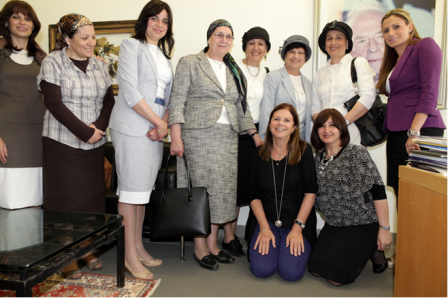Israel: Rabin center welcomes ultra-Orthodox women

Base for Discussion (B4D), and its engagement with the Traditional Religious population, is one of the key components of the Interpeace programme currently underway in Israel. Working in collaboration with the Jerusalem Haredic College and the Ben Gurion University, Interpeace recently put together an educational programme for ultra-orthodox women who are seeking Master Degrees in Conflict Resolution.
Their visit to the Rabin Center, which took place last Tuesday, May 1st, comes as part of Interpeace’s goal to expose these women to different political views in Israel. In addition, the two-year Master’s programme teaches conflict and resolution skills, mediation tactics, and English.
This occasion allowed the women to examine the fundamental changes that Yitzhak Rabin (1922-1995) brought about during his time as Israeli Prime Minister. Mr. Rabin, recipient of the 1994 Nobel Peace Prize, served two terms in office, from 1974-1977 and 1992 until his tragic death in 1995. The Prize, which applauds his efforts to create peace in the Middle East, is shared with former Palestinian leader Yasser Arafat and Shimon Peres, then Foreign Minister and now current president of the State of Israel.
Among the participants were Mrs. Adina Bar-Shalom, chairwoman of the Jerusalem Haredic College and daughter of the Rabi Ovadia Yossef, and Mrs. Yaffa Deri, manager of a social organization and wife of the former Shas leader Arie Deri. Also included were Mrs. Mazal Amar, wife of the chief Rabbi of Israel Shlomo Amaar, as well as Mrs. Zipora Lau, a social activist and daughter-in-law of Tel-Aviv chief Rabbi Yisrael Meir Lau.
Participants were invited to hear a lecture given by Mrs. Dalia Rabin, the head of the museum and daughter of the former Prime Minister Rabin. The group was then led on a guided tour through the museum which depicts the major events of Rabin’s life, along with the formulation of the modern state of Israel.
The tour was concluded by a workshop that focused on tolerance and democracy. The success of this day can be seen by the enthusiasm shared by many of the participants, who said that someday they hope to bring their children to see the museum and its significance.
